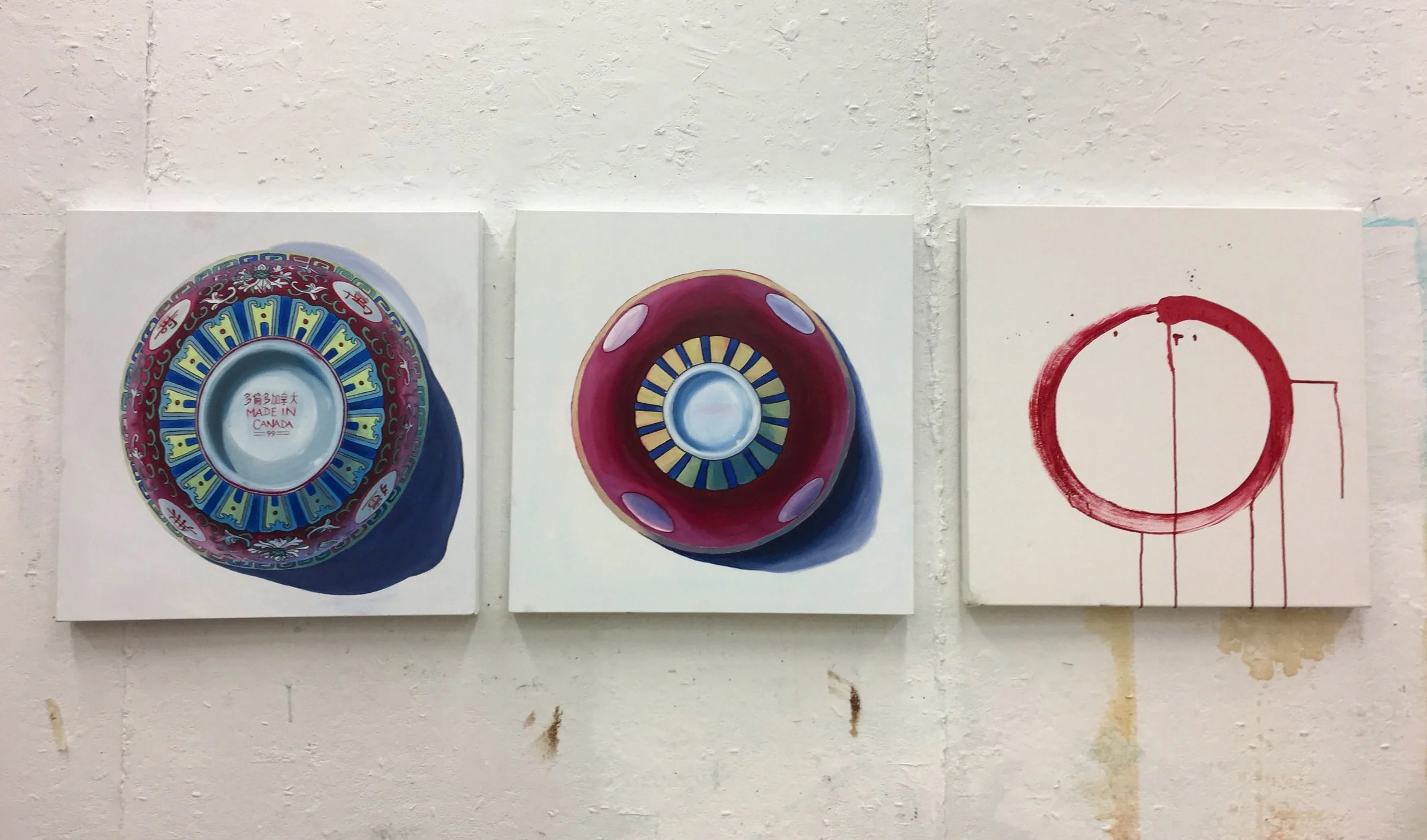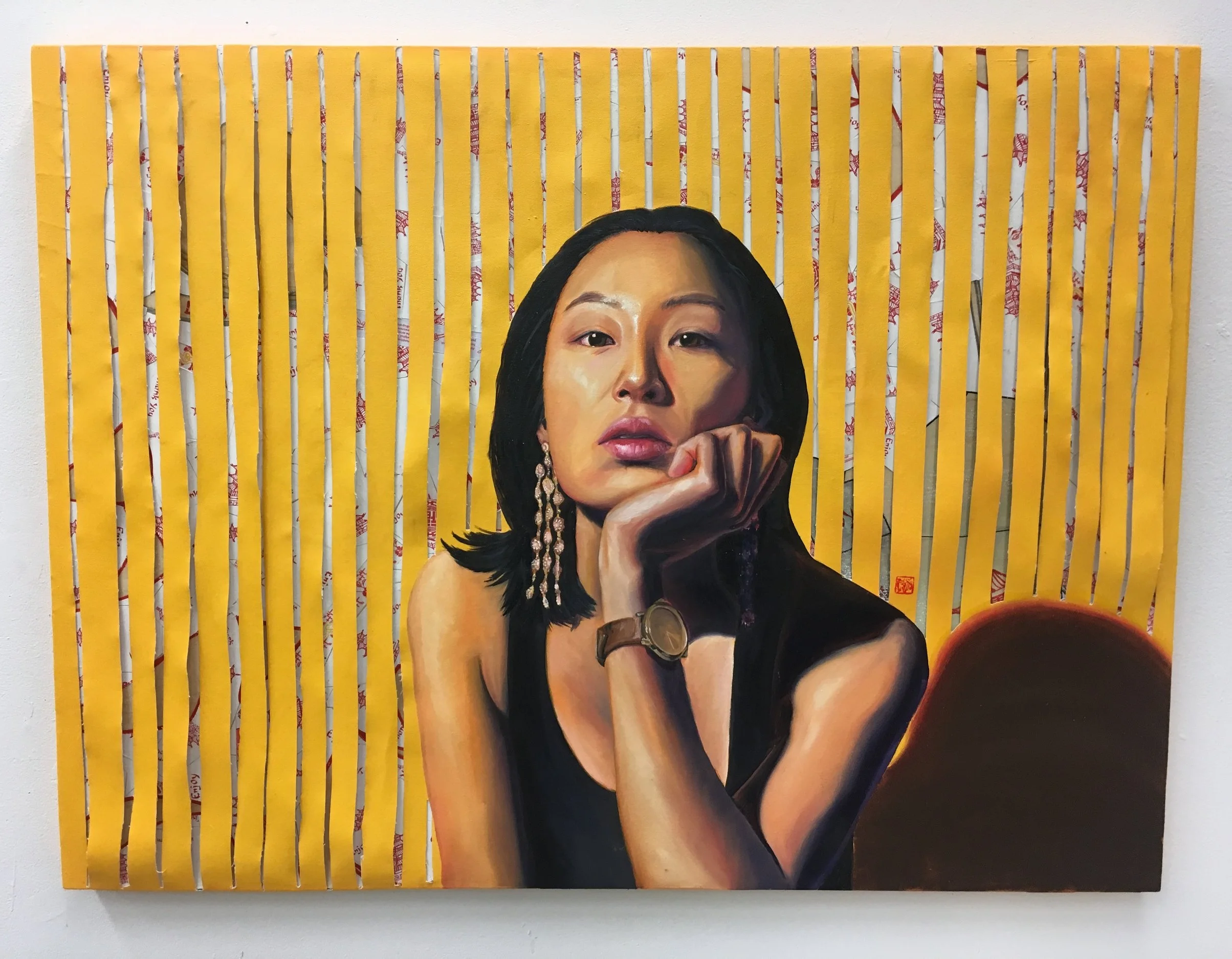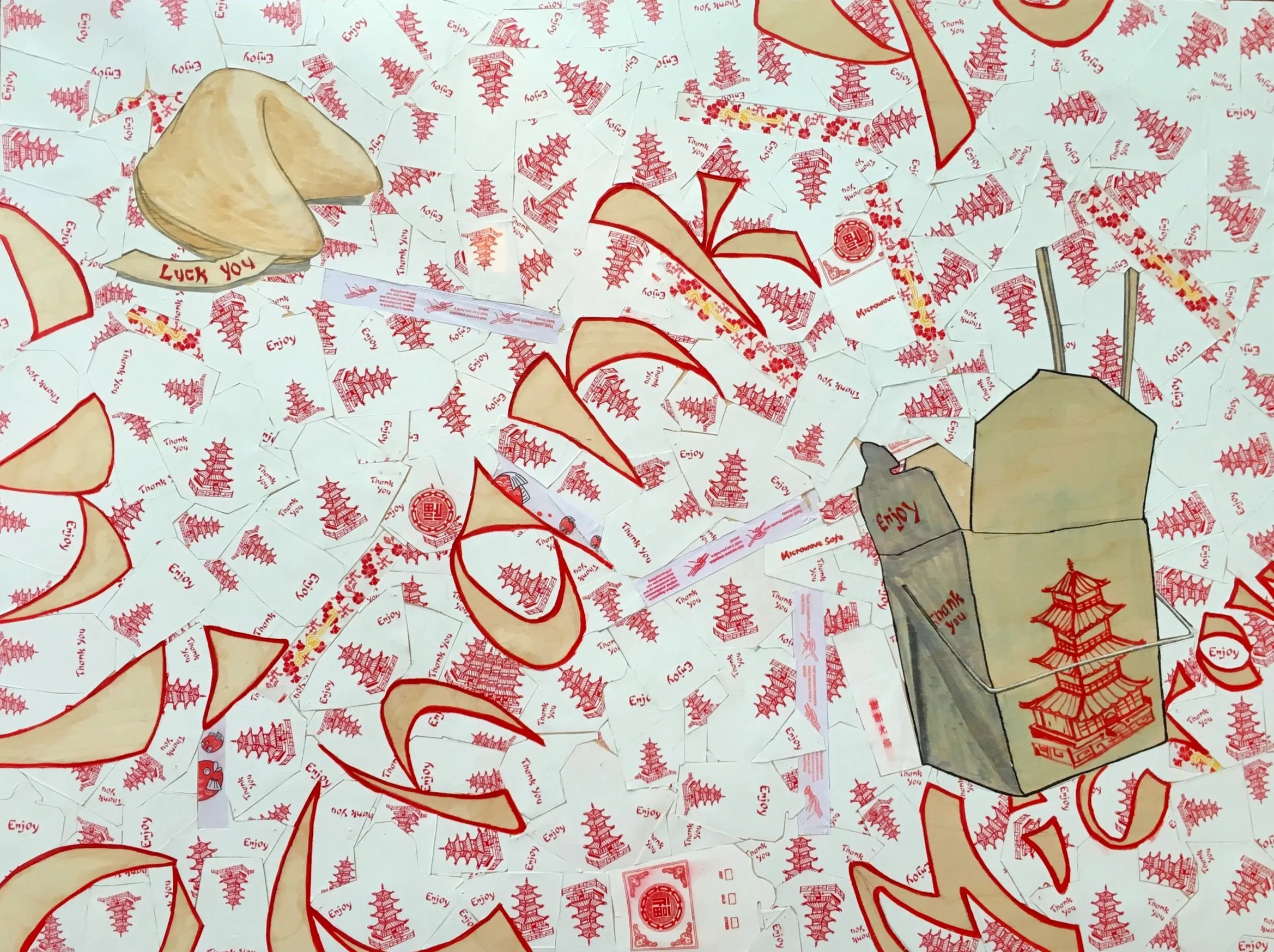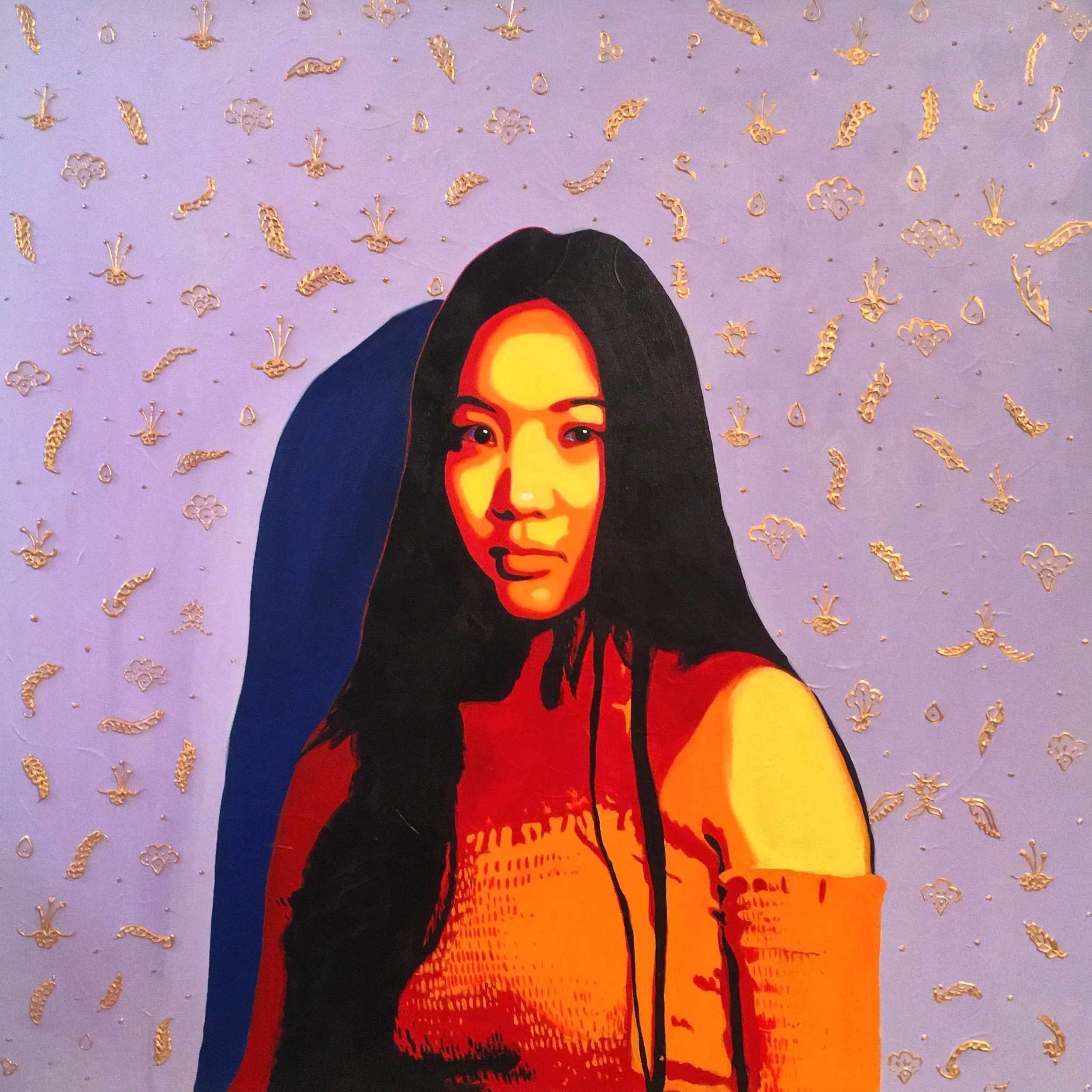
Kitchen Drawer
2024
Grandfather’s kitchen drawer, ceramic
24.5” x 12.5” x 4.5”

Moquette faite au Canada
2024
Grandfather’s carpet, ceramic
50” x 20” x 9”

Pendants through the kitchen chair
2024
Grandfather’s wooden chair, ceramic, jewellery thread
12’ x 17.5” x 17.5”






Joy Luck Club
2024
The Joy Luck Club Book by Amy Tan, ceramic



Green Onion Chandelier, 2024


Cut Pomelo, 2024

Hustler, 2023, 30" x 40"




Suzanne (iterations I, II & III), 2023, porcelain

Silky Black Chicken, 2023, 30x30", oil on canvas

For the love of God and Jade, 2023, oil on canvas, 8x10"

Jade Celadon Peanuts (in situ)

Jade Celadon Peanuts, 2022


Red Ginger, 2022

Pomelo, 2022
10” x 10”, oil on canvas

Old House, 2022, oil on canvas, 24" x 36"

First Time Homebuyer, 2022, oil on canvas, 30"x36"

Defecating Deity, 2021
60” x 48” x 2”
Oil on Canvas
My artistic practice challenges and reclaims stereotypes of Chinese women and their sexuality by interrogating fetishism fuelled by the gaze. This is supplemented by an investigation into diasporic culture. Oil paintings and organic matter sculpture - rooted in identity, help redefine visions of postcolonialism, through the confrontation of victimization with an unwavering stare - defiant and unafraid.
The translation and imitation of the patterns on porcelain have been recreated on the surface of biodegradable food products. Imitating memorialized designs hold a rich cultural history on organic objects which will change shape after a few weeks. Organic objects that represent bodies and hold imprints of distorted diasporas.
Like the Vanitas and Memento mori, these objects will eventually wither and rot, rejecting its polished beauty, and transforming into decay and disgust. Similarly, Caravaggio painted Basket of Fruit (1599) and Young Sick Bacchus (1593), sick bodies and rotting fruit, succumbed to worms and insects. At present, lemon, ginger, bok choy, bell pepper, and eggplant, have been gessoed and painted in acrylic, mimicking the patterns found on its porcelain counterparts.
The history of cross-cultural trade of ceramics and appropriation by the Dutch and other European rulers, led to chinoiserie becoming the popular fashion. Simultaneously migrants from these same cultures leave their homelands and build new diasporic futures in unfamiliar lands. Generations of lost connections informed the evolutions of these changes over time.
We are the fruit, grown and harvested from our ancestral vines, nourished by the water and sun of the resilient spirit that lives within us. My work, Defecating Deity, shamelessly excretes an intimate, vulnerable, and grotesque depiction of loss through sexuality and beauty, alongside the porcelain organic produce. Our bodies remain resilient, but have been transformed by the violence and effects of colonialism, withering with each generation to come, and depleting itself back into our colonial landfill.

Japanese Eggplant, 2021
My artistic practice challenges and reclaims stereotypes of Chinese women and their sexuality by interrogating fetishism fuelled by the gaze. This is supplemented by an investigation into diasporic culture. Oil paintings and organic matter sculpture - rooted in identity, help redefine visions of postcolonialism, through the confrontation of victimization with an unwavering stare - defiant and unafraid.
The translation and imitation of the patterns on porcelain have been recreated on the surface of biodegradable food products. Imitating memorialized designs hold a rich cultural history on organic objects which will change shape after a few weeks. Organic objects that represent bodies and hold imprints of distorted diasporas.
Like the Vanitas and Memento mori, these objects will eventually wither and rot, rejecting its polished beauty, and transforming into decay and disgust. Similarly, Caravaggio painted Basket of Fruit (1599) and Young Sick Bacchus (1593), sick bodies and rotting fruit, succumbed to worms and insects. At present, lemon, ginger, bok choy, bell pepper, and eggplant, have been gessoed and painted in acrylic, mimicking the patterns found on its porcelain counterparts.
The history of cross-cultural trade of ceramics and appropriation by the Dutch and other European rulers, led to chinoiserie becoming the popular fashion. Simultaneously migrants from these same cultures leave their homelands and build new diasporic futures in unfamiliar lands. Generations of lost connections informed the evolutions of these changes over time.
We are the fruit, grown and harvested from our ancestral vines, nourished by the water and sun of the resilient spirit that lives within us. My work, Defecating Deity, shamelessly excretes an intimate, vulnerable, and grotesque depiction of loss through sexuality and beauty, alongside the porcelain organic produce. Our bodies remain resilient, but have been transformed by the violence and effects of colonialism, withering with each generation to come, and depleting itself back into our colonial landfill.

That is quite classical, the orient.

Bell Pepper Imitation, 2021
My artistic practice challenges and reclaims stereotypes of Chinese women and their sexuality by interrogating fetishism fuelled by the gaze. This is supplemented by an investigation into diasporic culture. Oil paintings and organic matter sculpture - rooted in identity, help redefine visions of postcolonialism, through the confrontation of victimization with an unwavering stare - defiant and unafraid.
The translation and imitation of the patterns on porcelain have been recreated on the surface of biodegradable food products. Imitating memorialized designs hold a rich cultural history on organic objects which will change shape after a few weeks. Organic objects that represent bodies and hold imprints of distorted diasporas.
Like the Vanitas and Memento mori, these objects will eventually wither and rot, rejecting its polished beauty, and transforming into decay and disgust. Similarly, Caravaggio painted Basket of Fruit (1599) and Young Sick Bacchus (1593), sick bodies and rotting fruit, succumbed to worms and insects. At present, lemon, ginger, bok choy, bell pepper, and eggplant, have been gessoed and painted in acrylic, mimicking the patterns found on its porcelain counterparts.
The history of cross-cultural trade of ceramics and appropriation by the Dutch and other European rulers, led to chinoiserie becoming the popular fashion. Simultaneously migrants from these same cultures leave their homelands and build new diasporic futures in unfamiliar lands. Generations of lost connections informed the evolutions of these changes over time.
We are the fruit, grown and harvested from our ancestral vines, nourished by the water and sun of the resilient spirit that lives within us. My work, Defecating Deity, shamelessly excretes an intimate, vulnerable, and grotesque depiction of loss through sexuality and beauty, alongside the porcelain organic produce. Our bodies remain resilient, but have been transformed by the violence and effects of colonialism, withering with each generation to come, and depleting itself back into our colonial landfill.

Add Oil, 2021
Add Oil, 2021
oil and acrylic on canvas
24x24”

Ginger Imitation, 2021
Acrylic on Ginger, next to original vessel
My artistic practice challenges and reclaims stereotypes of Chinese women and their sexuality by interrogating fetishism fuelled by the gaze. This is supplemented by an investigation into diasporic culture. Oil paintings and organic matter sculpture - rooted in identity, help redefine visions of postcolonialism, through the confrontation of victimization with an unwavering stare - defiant and unafraid.
The translation and imitation of the patterns on porcelain have been recreated on the surface of biodegradable food products. Imitating memorialized designs hold a rich cultural history on organic objects which will change shape after a few weeks. Organic objects that represent bodies and hold imprints of distorted diasporas.
Like the Vanitas and Memento mori, these objects will eventually wither and rot, rejecting its polished beauty, and transforming into decay and disgust. Similarly, Caravaggio painted Basket of Fruit (1599) and Young Sick Bacchus (1593), sick bodies and rotting fruit, succumbed to worms and insects. At present, lemon, ginger, bok choy, bell pepper, and eggplant, have been gessoed and painted in acrylic, mimicking the patterns found on its porcelain counterparts.
The history of cross-cultural trade of ceramics and appropriation by the Dutch and other European rulers, led to chinoiserie becoming the popular fashion. Simultaneously migrants from these same cultures leave their homelands and build new diasporic futures in unfamiliar lands. Generations of lost connections informed the evolutions of these changes over time.
We are the fruit, grown and harvested from our ancestral vines, nourished by the water and sun of the resilient spirit that lives within us. My work, Defecating Deity, shamelessly excretes an intimate, vulnerable, and grotesque depiction of loss through sexuality and beauty, alongside the porcelain organic produce. Our bodies remain resilient, but have been transformed by the violence and effects of colonialism, withering with each generation to come, and depleting itself back into our colonial landfill.

Send Noods neon
2018

Bok Choy Imitation, 2021
Acrylic on Bok Choy, on original porcelain plate
My artistic practice challenges and reclaims stereotypes of Chinese women and their sexuality by interrogating fetishism fuelled by the gaze. This is supplemented by an investigation into diasporic culture. Oil paintings and organic matter sculpture - rooted in identity, help redefine visions of postcolonialism, through the confrontation of victimization with an unwavering stare - defiant and unafraid.
The translation and imitation of the patterns on porcelain have been recreated on the surface of biodegradable food products. Imitating memorialized designs hold a rich cultural history on organic objects which will change shape after a few weeks. Organic objects that represent bodies and hold imprints of distorted diasporas.
Like the Vanitas and Memento mori, these objects will eventually wither and rot, rejecting its polished beauty, and transforming into decay and disgust. Similarly, Caravaggio painted Basket of Fruit (1599) and Young Sick Bacchus (1593), sick bodies and rotting fruit, succumbed to worms and insects. At present, lemon, ginger, bok choy, bell pepper, and eggplant, have been gessoed and painted in acrylic, mimicking the patterns found on its porcelain counterparts.
The history of cross-cultural trade of ceramics and appropriation by the Dutch and other European rulers, led to chinoiserie becoming the popular fashion. Simultaneously migrants from these same cultures leave their homelands and build new diasporic futures in unfamiliar lands. Generations of lost connections informed the evolutions of these changes over time.
We are the fruit, grown and harvested from our ancestral vines, nourished by the water and sun of the resilient spirit that lives within us. My work, Defecating Deity, shamelessly excretes an intimate, vulnerable, and grotesque depiction of loss through sexuality and beauty, alongside the porcelain organic produce. Our bodies remain resilient, but have been transformed by the violence and effects of colonialism, withering with each generation to come, and depleting itself back into our colonial landfill.

The Coronation

Solidarity Painting, 2021
Oil and Acrylic on canvas
Oakland Brown Berets and Black Panthers at the Alameda County Courthouse in Downtown Oakland in 1968 at a Free Huey Newton Rally.

Maskini Study, 2020
Oil on frozen pizza cardboard

Purell against Blue and White Pattern, 2020

Pillow Talk, 2020

Lemon Porcelain Imitation, 2021
My artistic practice challenges and reclaims stereotypes of Chinese women and their sexuality by interrogating fetishism fuelled by the gaze. This is supplemented by an investigation into diasporic culture. Oil paintings and organic matter sculpture - rooted in identity, help redefine visions of postcolonialism, through the confrontation of victimization with an unwavering stare - defiant and unafraid.
The translation and imitation of the patterns on porcelain have been recreated on the surface of biodegradable food products. Imitating memorialized designs hold a rich cultural history on organic objects which will change shape after a few weeks. Organic objects that represent bodies and hold imprints of distorted diasporas.
Like the Vanitas and Memento mori, these objects will eventually wither and rot, rejecting its polished beauty, and transforming into decay and disgust. Similarly, Caravaggio painted Basket of Fruit (1599) and Young Sick Bacchus (1593), sick bodies and rotting fruit, succumbed to worms and insects. At present, lemon, ginger, bok choy, bell pepper, and eggplant, have been gessoed and painted in acrylic, mimicking the patterns found on its porcelain counterparts.
The history of cross-cultural trade of ceramics and appropriation by the Dutch and other European rulers, led to chinoiserie becoming the popular fashion. Simultaneously migrants from these same cultures leave their homelands and build new diasporic futures in unfamiliar lands. Generations of lost connections informed the evolutions of these changes over time.
We are the fruit, grown and harvested from our ancestral vines, nourished by the water and sun of the resilient spirit that lives within us. My work, Defecating Deity, shamelessly excretes an intimate, vulnerable, and grotesque depiction of loss through sexuality and beauty, alongside the porcelain organic produce. Our bodies remain resilient, but have been transformed by the violence and effects of colonialism, withering with each generation to come, and depleting itself back into our colonial landfill.

Supermarket Crabs, 2020
24” x 36”

2019

Dumpling House, 2019

self-portrait, 2019

NOT YOUR LITTLE CHINA GIRL
2018
oil on canvas
3.5 x 4.5 ft

Crawford, 2019

fish heads, 2019

2019

Krispy Kreme, 2019

Tavishi, study 2019

"Olivia, study"
2018
24” x 36” oil on canvas

study, 2019

"Old Father, to my son, to my granddaughter, after Choi Bik Lam"
Calligraphy appropriated from my great-grandfather, Choi Bik Lam
2018
3’ x 4’, oil on canvas

"Jessica"
2018
oil on canvas, currently in progress

"Jar, Still Life"
2019
24” x 36”, oil on canvas

"Bowl Abstraction"
2018

"Luck you"
2018
mixed media, 48” x 60” wood panel strainer
currently in progress

Underpainting to "Luck you"
2018
collaged take-out boxes on wood panel later covered in the piece “Luck you”

"Olivia"
2018
4’ x 4’, acrylic on canvas, gold gel medium piped with piping bag

The Great Wave
Commission as a hanging wall piece for an active skateboarder

Chalk Art
Collaborative chalk drawing. Japanese inspired tiger drawn for the "Chalk-off" competition at Unionville High School May 12, 2017

See "Reverence" for more info

Claustrophobia #1
First in a series of paintings that portray personal fears, Claustrophobia #1 depicts the idleness of fish in a space that does not allow freedom to move. Limited by it's barrier of glass and mind, the fish must endure a monotonous quiet of loneliness and emptiness.

Claustrophobia #2
Second in its series of paintings that portray personal fears, Claustrophobia #2 depicts the crowding of fish in a space that does not allow freedom to move. Limited by it's barrier of glass and mind, the fish must endure a monotonous quietness, surrounded by others of its kind.


































































